Psychology: Drug Addiction Assignment 1 - Zinberg Model
VerifiedAdded on 2023/06/07
|7
|1603
|226
Homework Assignment
AI Summary
This assignment delves into the multifaceted realm of drug addiction, commencing with an exploration of Zinberg's interaction model, which elucidates the interplay between the drug's properties, the user's characteristics, and the environment. The assignment then examines the subjective experiences associated with specific substances, including heroin, alcohol, and MDMA. It analyzes how heroin's conversion to morphine and its interaction with opioid receptors produce euphoric sensations, while also discussing the feelings of well-being and warmth reported by users. Regarding alcohol, the assignment explores subjective responses, the impact on mood, and the masking of negative emotions. Lastly, it investigates MDMA, its effects on perception and mood, and the resulting experiences of ecstasy and dysphoria, as well as the potential for psychiatric symptoms. The assignment references relevant literature to support its analysis.

Running head: DRUG ADDICTION
Assignment 1
Name of the Student
Name of the University
Author Note
Assignment 1
Name of the Student
Name of the University
Author Note
Paraphrase This Document
Need a fresh take? Get an instant paraphrase of this document with our AI Paraphraser
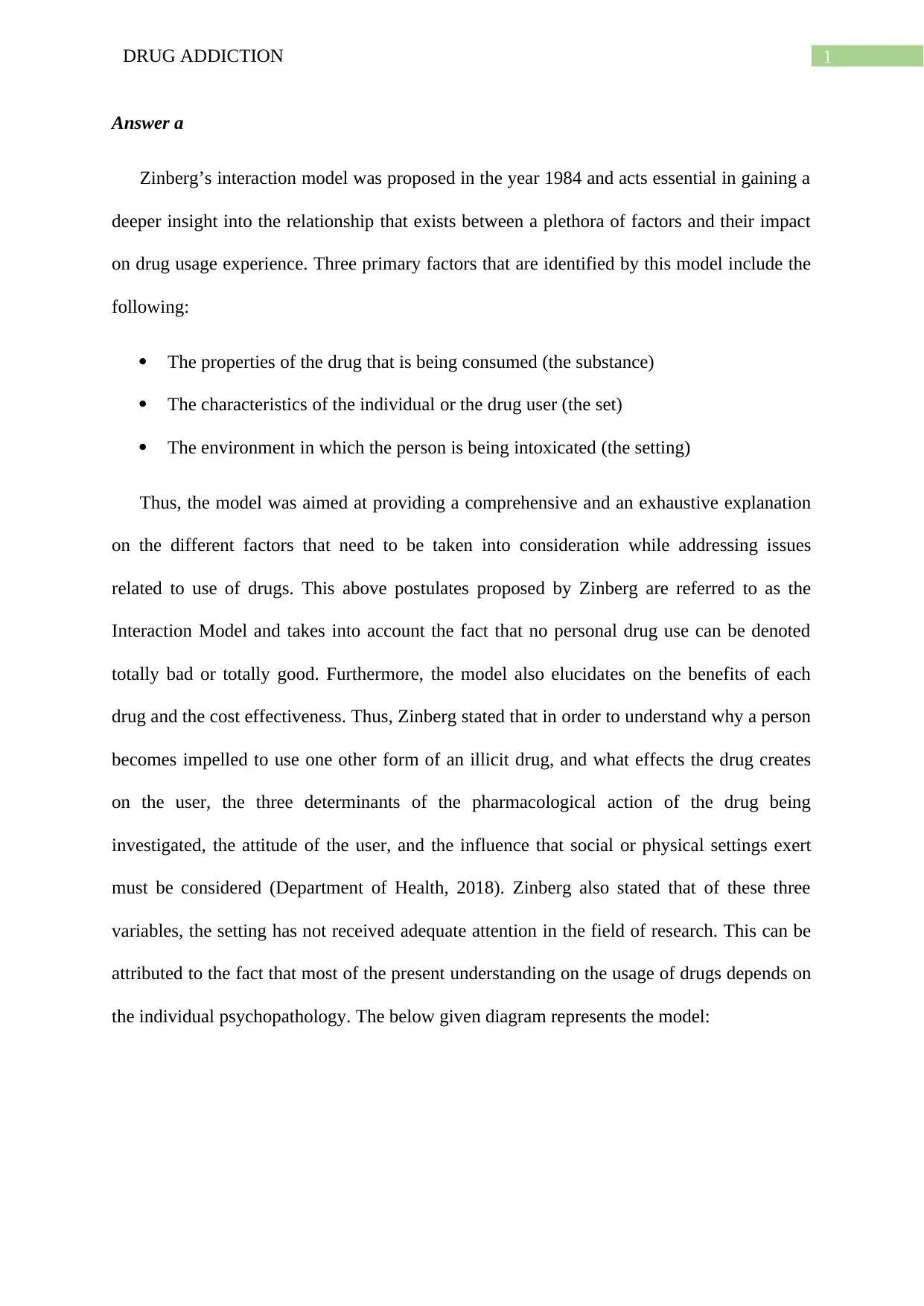
1DRUG ADDICTION
Answer a
Zinberg’s interaction model was proposed in the year 1984 and acts essential in gaining a
deeper insight into the relationship that exists between a plethora of factors and their impact
on drug usage experience. Three primary factors that are identified by this model include the
following:
The properties of the drug that is being consumed (the substance)
The characteristics of the individual or the drug user (the set)
The environment in which the person is being intoxicated (the setting)
Thus, the model was aimed at providing a comprehensive and an exhaustive explanation
on the different factors that need to be taken into consideration while addressing issues
related to use of drugs. This above postulates proposed by Zinberg are referred to as the
Interaction Model and takes into account the fact that no personal drug use can be denoted
totally bad or totally good. Furthermore, the model also elucidates on the benefits of each
drug and the cost effectiveness. Thus, Zinberg stated that in order to understand why a person
becomes impelled to use one other form of an illicit drug, and what effects the drug creates
on the user, the three determinants of the pharmacological action of the drug being
investigated, the attitude of the user, and the influence that social or physical settings exert
must be considered (Department of Health, 2018). Zinberg also stated that of these three
variables, the setting has not received adequate attention in the field of research. This can be
attributed to the fact that most of the present understanding on the usage of drugs depends on
the individual psychopathology. The below given diagram represents the model:
Answer a
Zinberg’s interaction model was proposed in the year 1984 and acts essential in gaining a
deeper insight into the relationship that exists between a plethora of factors and their impact
on drug usage experience. Three primary factors that are identified by this model include the
following:
The properties of the drug that is being consumed (the substance)
The characteristics of the individual or the drug user (the set)
The environment in which the person is being intoxicated (the setting)
Thus, the model was aimed at providing a comprehensive and an exhaustive explanation
on the different factors that need to be taken into consideration while addressing issues
related to use of drugs. This above postulates proposed by Zinberg are referred to as the
Interaction Model and takes into account the fact that no personal drug use can be denoted
totally bad or totally good. Furthermore, the model also elucidates on the benefits of each
drug and the cost effectiveness. Thus, Zinberg stated that in order to understand why a person
becomes impelled to use one other form of an illicit drug, and what effects the drug creates
on the user, the three determinants of the pharmacological action of the drug being
investigated, the attitude of the user, and the influence that social or physical settings exert
must be considered (Department of Health, 2018). Zinberg also stated that of these three
variables, the setting has not received adequate attention in the field of research. This can be
attributed to the fact that most of the present understanding on the usage of drugs depends on
the individual psychopathology. The below given diagram represents the model:
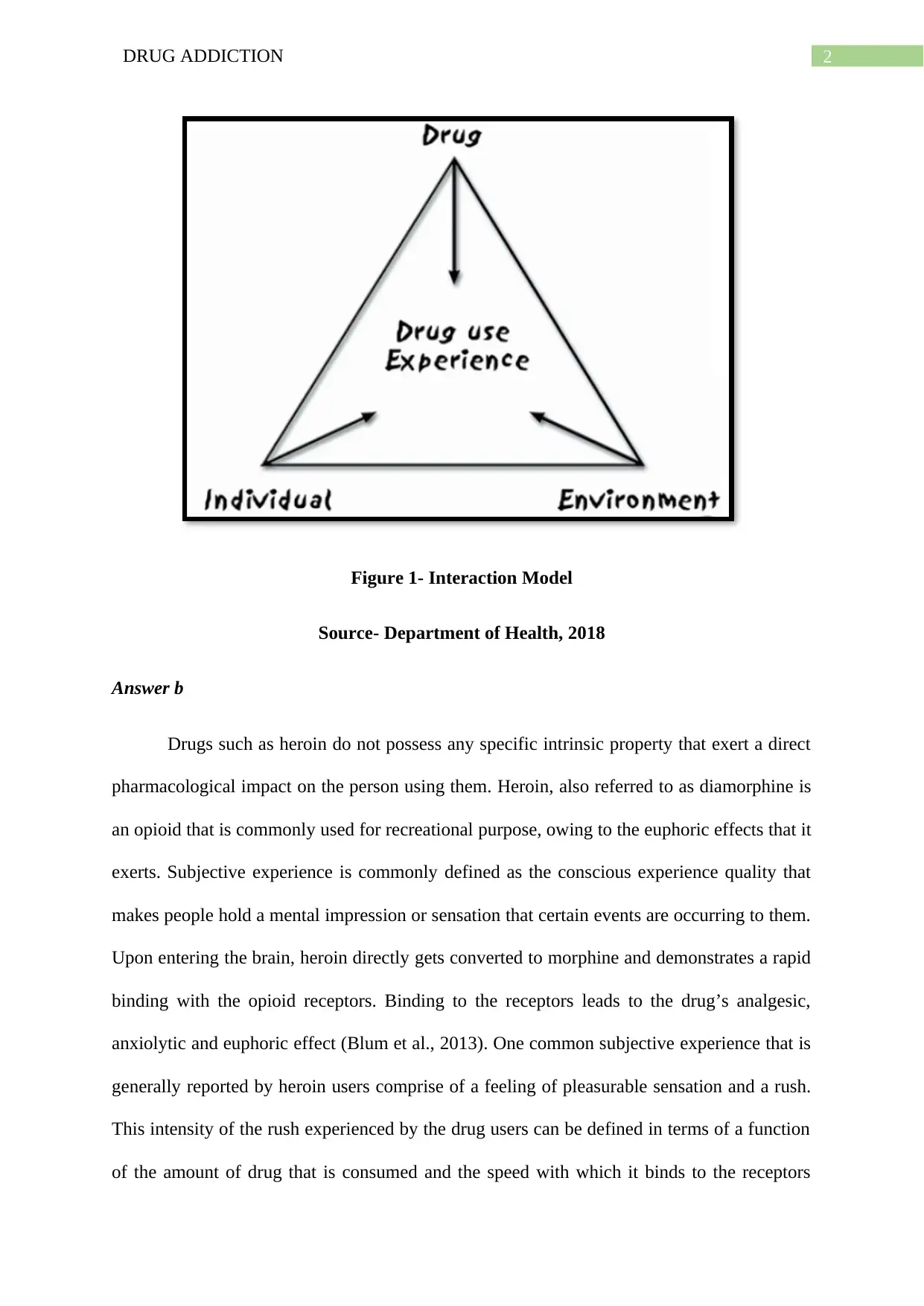
2DRUG ADDICTION
Figure 1- Interaction Model
Source- Department of Health, 2018
Answer b
Drugs such as heroin do not possess any specific intrinsic property that exert a direct
pharmacological impact on the person using them. Heroin, also referred to as diamorphine is
an opioid that is commonly used for recreational purpose, owing to the euphoric effects that it
exerts. Subjective experience is commonly defined as the conscious experience quality that
makes people hold a mental impression or sensation that certain events are occurring to them.
Upon entering the brain, heroin directly gets converted to morphine and demonstrates a rapid
binding with the opioid receptors. Binding to the receptors leads to the drug’s analgesic,
anxiolytic and euphoric effect (Blum et al., 2013). One common subjective experience that is
generally reported by heroin users comprise of a feeling of pleasurable sensation and a rush.
This intensity of the rush experienced by the drug users can be defined in terms of a function
of the amount of drug that is consumed and the speed with which it binds to the receptors
Figure 1- Interaction Model
Source- Department of Health, 2018
Answer b
Drugs such as heroin do not possess any specific intrinsic property that exert a direct
pharmacological impact on the person using them. Heroin, also referred to as diamorphine is
an opioid that is commonly used for recreational purpose, owing to the euphoric effects that it
exerts. Subjective experience is commonly defined as the conscious experience quality that
makes people hold a mental impression or sensation that certain events are occurring to them.
Upon entering the brain, heroin directly gets converted to morphine and demonstrates a rapid
binding with the opioid receptors. Binding to the receptors leads to the drug’s analgesic,
anxiolytic and euphoric effect (Blum et al., 2013). One common subjective experience that is
generally reported by heroin users comprise of a feeling of pleasurable sensation and a rush.
This intensity of the rush experienced by the drug users can be defined in terms of a function
of the amount of drug that is consumed and the speed with which it binds to the receptors
⊘ This is a preview!⊘
Do you want full access?
Subscribe today to unlock all pages.

Trusted by 1+ million students worldwide
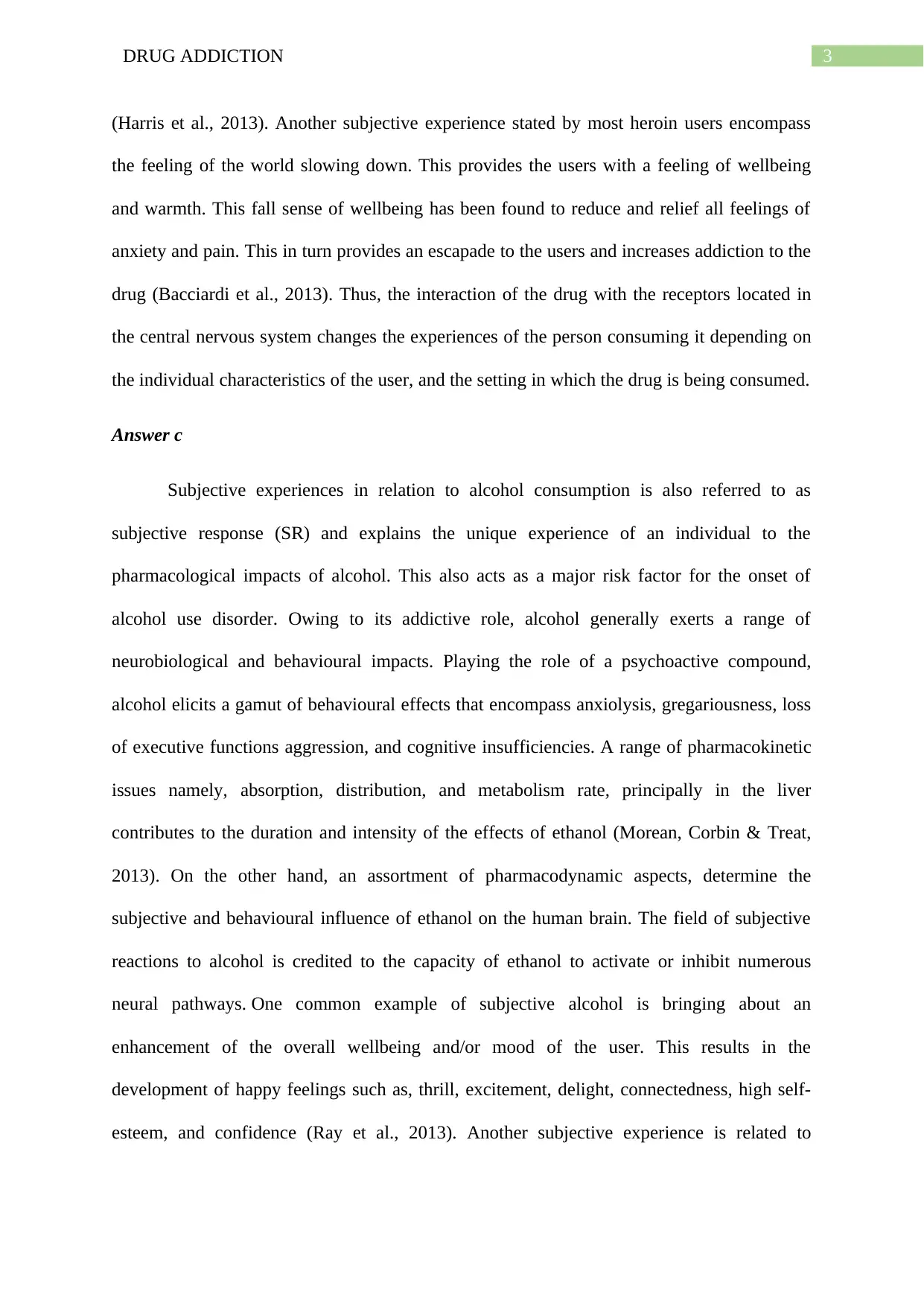
3DRUG ADDICTION
(Harris et al., 2013). Another subjective experience stated by most heroin users encompass
the feeling of the world slowing down. This provides the users with a feeling of wellbeing
and warmth. This fall sense of wellbeing has been found to reduce and relief all feelings of
anxiety and pain. This in turn provides an escapade to the users and increases addiction to the
drug (Bacciardi et al., 2013). Thus, the interaction of the drug with the receptors located in
the central nervous system changes the experiences of the person consuming it depending on
the individual characteristics of the user, and the setting in which the drug is being consumed.
Answer c
Subjective experiences in relation to alcohol consumption is also referred to as
subjective response (SR) and explains the unique experience of an individual to the
pharmacological impacts of alcohol. This also acts as a major risk factor for the onset of
alcohol use disorder. Owing to its addictive role, alcohol generally exerts a range of
neurobiological and behavioural impacts. Playing the role of a psychoactive compound,
alcohol elicits a gamut of behavioural effects that encompass anxiolysis, gregariousness, loss
of executive functions aggression, and cognitive insufficiencies. A range of pharmacokinetic
issues namely, absorption, distribution, and metabolism rate, principally in the liver
contributes to the duration and intensity of the effects of ethanol (Morean, Corbin & Treat,
2013). On the other hand, an assortment of pharmacodynamic aspects, determine the
subjective and behavioural influence of ethanol on the human brain. The field of subjective
reactions to alcohol is credited to the capacity of ethanol to activate or inhibit numerous
neural pathways. One common example of subjective alcohol is bringing about an
enhancement of the overall wellbeing and/or mood of the user. This results in the
development of happy feelings such as, thrill, excitement, delight, connectedness, high self-
esteem, and confidence (Ray et al., 2013). Another subjective experience is related to
(Harris et al., 2013). Another subjective experience stated by most heroin users encompass
the feeling of the world slowing down. This provides the users with a feeling of wellbeing
and warmth. This fall sense of wellbeing has been found to reduce and relief all feelings of
anxiety and pain. This in turn provides an escapade to the users and increases addiction to the
drug (Bacciardi et al., 2013). Thus, the interaction of the drug with the receptors located in
the central nervous system changes the experiences of the person consuming it depending on
the individual characteristics of the user, and the setting in which the drug is being consumed.
Answer c
Subjective experiences in relation to alcohol consumption is also referred to as
subjective response (SR) and explains the unique experience of an individual to the
pharmacological impacts of alcohol. This also acts as a major risk factor for the onset of
alcohol use disorder. Owing to its addictive role, alcohol generally exerts a range of
neurobiological and behavioural impacts. Playing the role of a psychoactive compound,
alcohol elicits a gamut of behavioural effects that encompass anxiolysis, gregariousness, loss
of executive functions aggression, and cognitive insufficiencies. A range of pharmacokinetic
issues namely, absorption, distribution, and metabolism rate, principally in the liver
contributes to the duration and intensity of the effects of ethanol (Morean, Corbin & Treat,
2013). On the other hand, an assortment of pharmacodynamic aspects, determine the
subjective and behavioural influence of ethanol on the human brain. The field of subjective
reactions to alcohol is credited to the capacity of ethanol to activate or inhibit numerous
neural pathways. One common example of subjective alcohol is bringing about an
enhancement of the overall wellbeing and/or mood of the user. This results in the
development of happy feelings such as, thrill, excitement, delight, connectedness, high self-
esteem, and confidence (Ray et al., 2013). Another subjective experience is related to
Paraphrase This Document
Need a fresh take? Get an instant paraphrase of this document with our AI Paraphraser
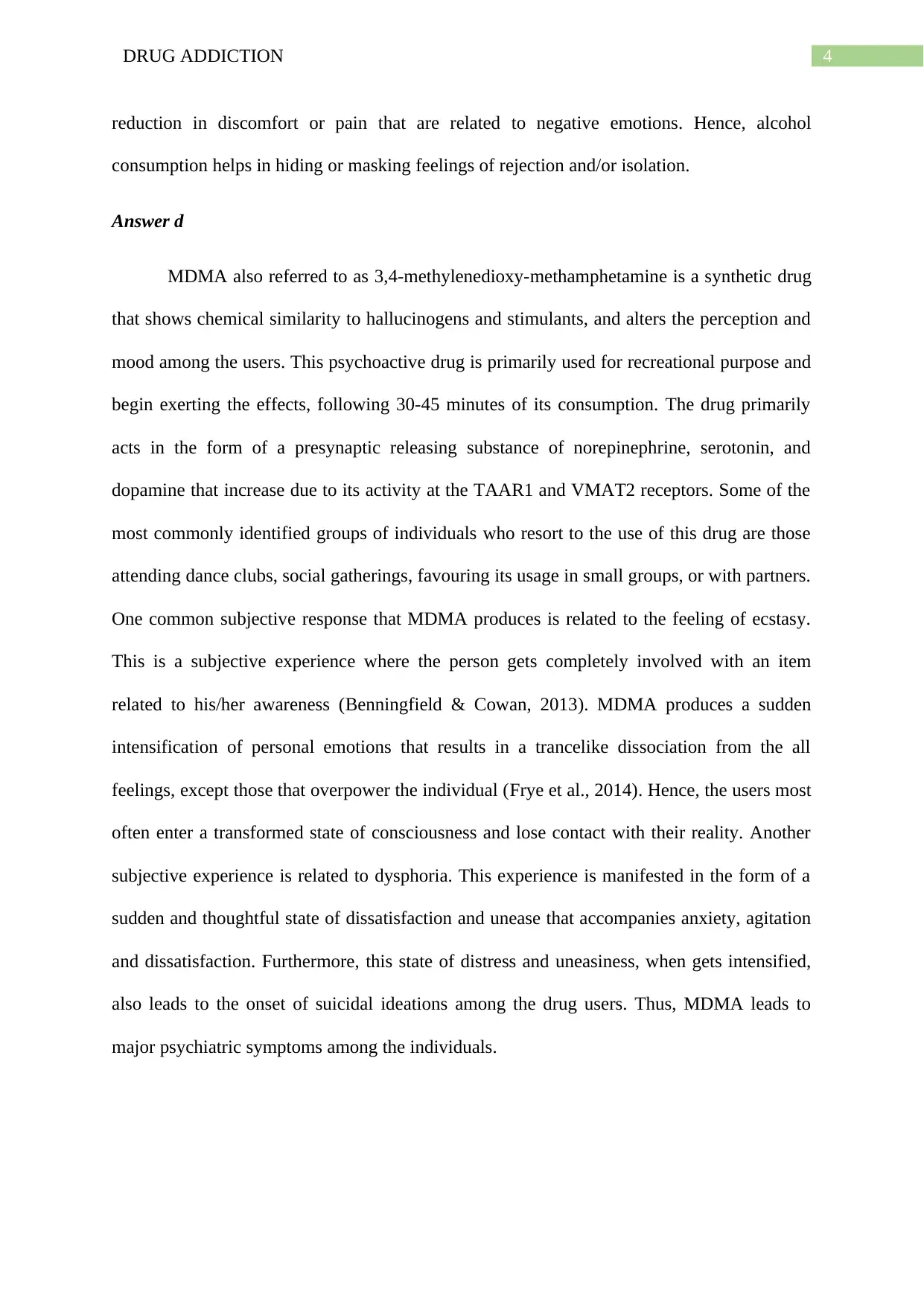
4DRUG ADDICTION
reduction in discomfort or pain that are related to negative emotions. Hence, alcohol
consumption helps in hiding or masking feelings of rejection and/or isolation.
Answer d
MDMA also referred to as 3,4-methylenedioxy-methamphetamine is a synthetic drug
that shows chemical similarity to hallucinogens and stimulants, and alters the perception and
mood among the users. This psychoactive drug is primarily used for recreational purpose and
begin exerting the effects, following 30-45 minutes of its consumption. The drug primarily
acts in the form of a presynaptic releasing substance of norepinephrine, serotonin, and
dopamine that increase due to its activity at the TAAR1 and VMAT2 receptors. Some of the
most commonly identified groups of individuals who resort to the use of this drug are those
attending dance clubs, social gatherings, favouring its usage in small groups, or with partners.
One common subjective response that MDMA produces is related to the feeling of ecstasy.
This is a subjective experience where the person gets completely involved with an item
related to his/her awareness (Benningfield & Cowan, 2013). MDMA produces a sudden
intensification of personal emotions that results in a trancelike dissociation from the all
feelings, except those that overpower the individual (Frye et al., 2014). Hence, the users most
often enter a transformed state of consciousness and lose contact with their reality. Another
subjective experience is related to dysphoria. This experience is manifested in the form of a
sudden and thoughtful state of dissatisfaction and unease that accompanies anxiety, agitation
and dissatisfaction. Furthermore, this state of distress and uneasiness, when gets intensified,
also leads to the onset of suicidal ideations among the drug users. Thus, MDMA leads to
major psychiatric symptoms among the individuals.
reduction in discomfort or pain that are related to negative emotions. Hence, alcohol
consumption helps in hiding or masking feelings of rejection and/or isolation.
Answer d
MDMA also referred to as 3,4-methylenedioxy-methamphetamine is a synthetic drug
that shows chemical similarity to hallucinogens and stimulants, and alters the perception and
mood among the users. This psychoactive drug is primarily used for recreational purpose and
begin exerting the effects, following 30-45 minutes of its consumption. The drug primarily
acts in the form of a presynaptic releasing substance of norepinephrine, serotonin, and
dopamine that increase due to its activity at the TAAR1 and VMAT2 receptors. Some of the
most commonly identified groups of individuals who resort to the use of this drug are those
attending dance clubs, social gatherings, favouring its usage in small groups, or with partners.
One common subjective response that MDMA produces is related to the feeling of ecstasy.
This is a subjective experience where the person gets completely involved with an item
related to his/her awareness (Benningfield & Cowan, 2013). MDMA produces a sudden
intensification of personal emotions that results in a trancelike dissociation from the all
feelings, except those that overpower the individual (Frye et al., 2014). Hence, the users most
often enter a transformed state of consciousness and lose contact with their reality. Another
subjective experience is related to dysphoria. This experience is manifested in the form of a
sudden and thoughtful state of dissatisfaction and unease that accompanies anxiety, agitation
and dissatisfaction. Furthermore, this state of distress and uneasiness, when gets intensified,
also leads to the onset of suicidal ideations among the drug users. Thus, MDMA leads to
major psychiatric symptoms among the individuals.
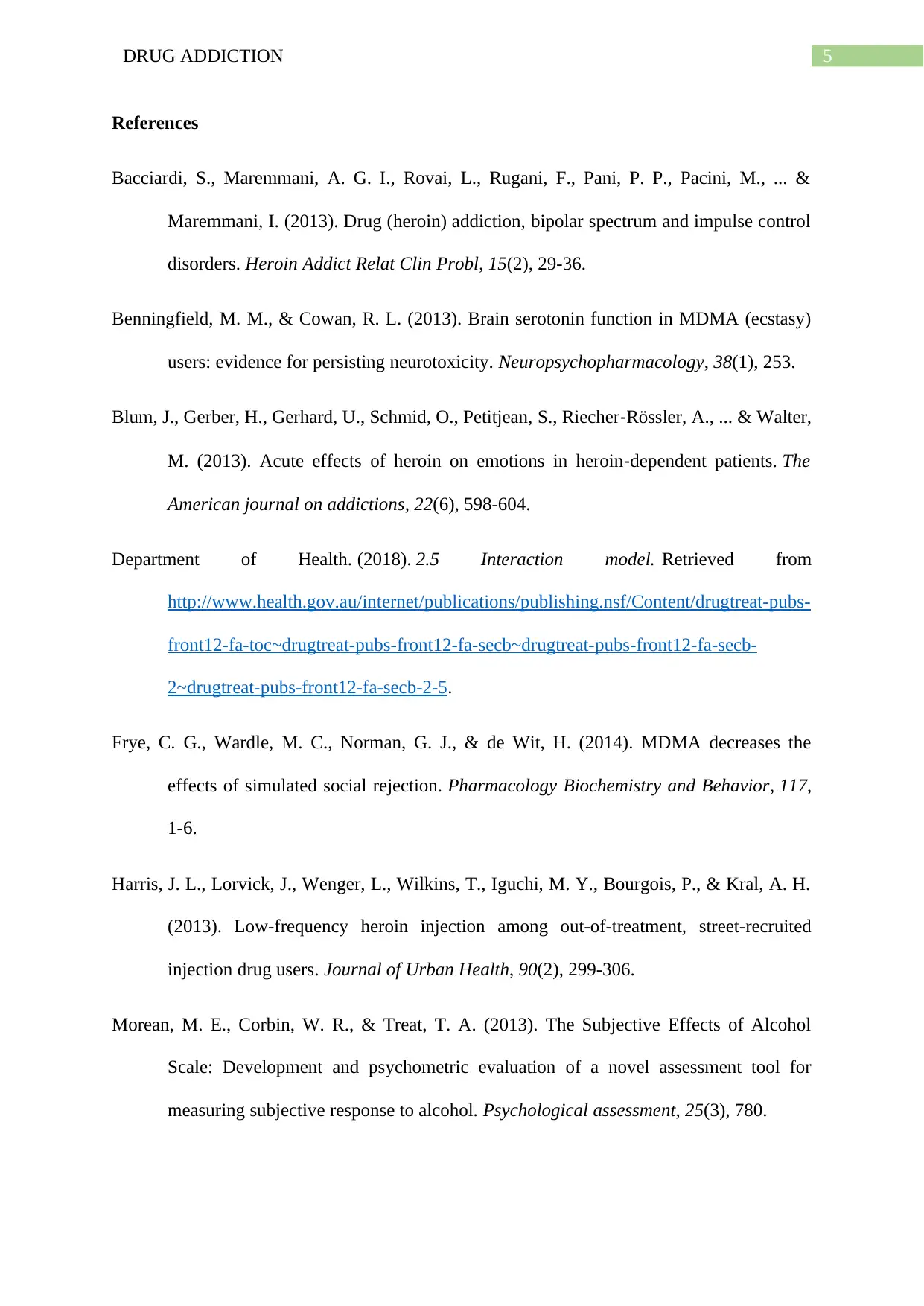
5DRUG ADDICTION
References
Bacciardi, S., Maremmani, A. G. I., Rovai, L., Rugani, F., Pani, P. P., Pacini, M., ... &
Maremmani, I. (2013). Drug (heroin) addiction, bipolar spectrum and impulse control
disorders. Heroin Addict Relat Clin Probl, 15(2), 29-36.
Benningfield, M. M., & Cowan, R. L. (2013). Brain serotonin function in MDMA (ecstasy)
users: evidence for persisting neurotoxicity. Neuropsychopharmacology, 38(1), 253.
Blum, J., Gerber, H., Gerhard, U., Schmid, O., Petitjean, S., Riecher‐Rössler, A., ... & Walter,
M. (2013). Acute effects of heroin on emotions in heroin‐dependent patients. The
American journal on addictions, 22(6), 598-604.
Department of Health. (2018). 2.5 Interaction model. Retrieved from
http://www.health.gov.au/internet/publications/publishing.nsf/Content/drugtreat-pubs-
front12-fa-toc~drugtreat-pubs-front12-fa-secb~drugtreat-pubs-front12-fa-secb-
2~drugtreat-pubs-front12-fa-secb-2-5.
Frye, C. G., Wardle, M. C., Norman, G. J., & de Wit, H. (2014). MDMA decreases the
effects of simulated social rejection. Pharmacology Biochemistry and Behavior, 117,
1-6.
Harris, J. L., Lorvick, J., Wenger, L., Wilkins, T., Iguchi, M. Y., Bourgois, P., & Kral, A. H.
(2013). Low-frequency heroin injection among out-of-treatment, street-recruited
injection drug users. Journal of Urban Health, 90(2), 299-306.
Morean, M. E., Corbin, W. R., & Treat, T. A. (2013). The Subjective Effects of Alcohol
Scale: Development and psychometric evaluation of a novel assessment tool for
measuring subjective response to alcohol. Psychological assessment, 25(3), 780.
References
Bacciardi, S., Maremmani, A. G. I., Rovai, L., Rugani, F., Pani, P. P., Pacini, M., ... &
Maremmani, I. (2013). Drug (heroin) addiction, bipolar spectrum and impulse control
disorders. Heroin Addict Relat Clin Probl, 15(2), 29-36.
Benningfield, M. M., & Cowan, R. L. (2013). Brain serotonin function in MDMA (ecstasy)
users: evidence for persisting neurotoxicity. Neuropsychopharmacology, 38(1), 253.
Blum, J., Gerber, H., Gerhard, U., Schmid, O., Petitjean, S., Riecher‐Rössler, A., ... & Walter,
M. (2013). Acute effects of heroin on emotions in heroin‐dependent patients. The
American journal on addictions, 22(6), 598-604.
Department of Health. (2018). 2.5 Interaction model. Retrieved from
http://www.health.gov.au/internet/publications/publishing.nsf/Content/drugtreat-pubs-
front12-fa-toc~drugtreat-pubs-front12-fa-secb~drugtreat-pubs-front12-fa-secb-
2~drugtreat-pubs-front12-fa-secb-2-5.
Frye, C. G., Wardle, M. C., Norman, G. J., & de Wit, H. (2014). MDMA decreases the
effects of simulated social rejection. Pharmacology Biochemistry and Behavior, 117,
1-6.
Harris, J. L., Lorvick, J., Wenger, L., Wilkins, T., Iguchi, M. Y., Bourgois, P., & Kral, A. H.
(2013). Low-frequency heroin injection among out-of-treatment, street-recruited
injection drug users. Journal of Urban Health, 90(2), 299-306.
Morean, M. E., Corbin, W. R., & Treat, T. A. (2013). The Subjective Effects of Alcohol
Scale: Development and psychometric evaluation of a novel assessment tool for
measuring subjective response to alcohol. Psychological assessment, 25(3), 780.
⊘ This is a preview!⊘
Do you want full access?
Subscribe today to unlock all pages.

Trusted by 1+ million students worldwide

6DRUG ADDICTION
Ray, L. A., Bujarski, S., MacKillop, J., Courtney, K. E., Monti, P. M., & Miotto, K. (2013).
Subjective response to alcohol among alcohol‐dependent individuals: effects of the
mu‐opioid receptor (OPRM1) gene and alcoholism severity. Alcoholism: Clinical and
Experimental Research, 37, E116-E124.
Ray, L. A., Bujarski, S., MacKillop, J., Courtney, K. E., Monti, P. M., & Miotto, K. (2013).
Subjective response to alcohol among alcohol‐dependent individuals: effects of the
mu‐opioid receptor (OPRM1) gene and alcoholism severity. Alcoholism: Clinical and
Experimental Research, 37, E116-E124.
1 out of 7
Your All-in-One AI-Powered Toolkit for Academic Success.
+13062052269
info@desklib.com
Available 24*7 on WhatsApp / Email
![[object Object]](/_next/static/media/star-bottom.7253800d.svg)
Unlock your academic potential
Copyright © 2020–2025 A2Z Services. All Rights Reserved. Developed and managed by ZUCOL.
